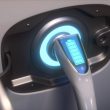Battery-swap tech pitching for heavy-duty trucks
Battery-swap technology can restore stakeholders’ enthusiasm in battery-electric haulage, according to Lex Forsyth, co-founder and general manager of Australian start-up Janus Electric.
For the last two or three years, we have seen carriers and truck manufacturers lose faith in battery-electric drivetrains. First and foremost, this is because most fleet owners are unhappy with drivers’ two-hour “coffee breaks” while their truck is connected to a DC charger. Fast progress in cell chemistry is yet another challenge.
Endless rollouts of ever-better batteries is naturally good news, yet long-haulers are built for many years of work and definitely not expected to be obsolete in just five years or so.
“That’s why fixed battery solutions for Class 8 prime movers don’t make sense to me,” Forsyth said. He suggests that the battery-swapping model’s three-minute “change and charge” concept is the obvious solution to the industry’s charging-time issue. However, it can also help to easily upgrade trucks for more advanced batteries: “We can just change the cell technology in the pack, as soon as a new one becomes economically viable.”
The swap infrastructure can also increase use of the existing power capacities, because charging can be paused when the demand is at a peak, and some of the stored energy can even be sold back to the grid in those periods.
Forsyth said: “Everyone seems to think that electrical grids just support fast charging because they put DC chargers everywhere but fast-charging technology conflicts with the grids’ necessity to use as much renewable energy as possible.”
To read the complete article, visit TU-Automotive.

















